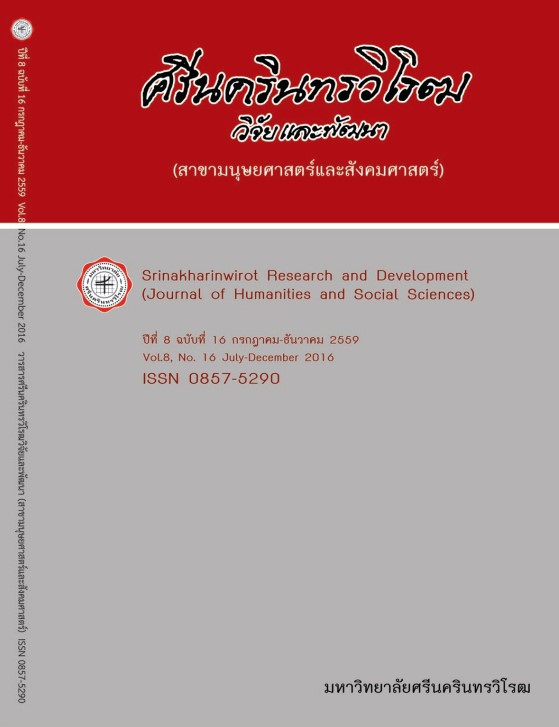การศึกษาชื่อน้ำพริกใน 4 ภาค : ภาพสะท้อนความเป็นอยู่และวัฒนธรรมไทย THE STUDY OF THE CHILLI PASTE NAMES IN 4 REGIONS OF THAILAND:THE REFLECTION OF THAI LIVING AND CULTURE
Keywords:
Chilli paste names, Thai living and culture, EthnosemanticsAbstract
บทคัดย่อ
การศึกษาครั้งนี้มีวัตถุประสงค์เพื่อศึกษาเกณฑ์และกลวิธีการตั้งชื่อน้ำพริก วิเคราะห์ความหมายของ ชื่อน้ำพริก และวิเคราะห์ความสัมพันธ์ทางความหมายของชื่อน้ำพริกกับสภาพความเป็นอยู่ของสังคมและวัฒนธรรมไทย ผู้วิจัยเก็บรวบรวมข้อมูลจากหนังสือหรือตำราทำน้ำพริกและสัมภาษณ์แบบเป็นกันเอง แนวคิดที่ใช้เป็นพื้นฐานในการวิเคราะห์ข้อมูลคือแนวคิดด้านอรรถศาสตร์ชาติพันธุ์ ผลการศึกษาพบว่าโครงสร้างของชื่อน้ำพริกใน 4 ภาคของไทยประกอบด้วย ‘ส่วนหลัก + ส่วนขยาย’ เกณฑ์ที่ใช้ในการตั้งชื่อน้ำพริกมีทั้งหมด 13 เกณฑ์ ได้แก่ วัตถุดิบสำคัญ สี วิธีทำ ชื่อเฉพาะ กิริยาอาการ ชนิดของอาหาร สถานที่ ลักษณะ ภาชนะ พาหนะ ความเชื่อทางศาสนา เครื่องเคียง และคำเชื่อม กลวิธีการตั้งชื่อน้ำพริกแบ่งออกได้เป็น 3 กลวิธีใหญ่ ได้แก่ กลวิธีการตั้งชื่อน้ำพริกโดยใช้เกณฑ์เดียว กลวิธีการตั้งชื่อน้ำพริกโดยใช้สองเกณฑ์ประกอบกัน และกลวิธีการตั้ง ชื่อน้ำพริกโดยใช้สามเกณฑ์ประกอบกัน ผลการวิเคราะห์ความหมายของชื่อน้ำพริกโดยใช้เกณฑ์การจัดกลุ่มความหมาย พบว่าชื่อน้ำพริกจัดอยู่ในกลุ่มความหมายต่างๆ 9 กลุ่มความหมาย ได้แก่ อาหารและวิธีทำ สี ชื่อเฉพาะ กิริยาอาการ สถานที่ ภาชนะ ความเชื่อทางศาสนา พาหนะ และคำเชื่อม การวิเคราะห์ความสัมพันธ์ทางความหมายของชื่อน้ำพริกกับสภาพความเป็นอยู่ของสังคมและวัฒนธรรมไทยสะท้อนถึงการนำวัตถุดิบที่แตกต่างกันมาปรุงน้ำพริก รวมถึงวิธีทำน้ำพริกที่ทำให้แต่ละภาคมีเอกลักษณ์แตกต่างกัน และแสดงให้เห็นถึงภูมิปัญญาท้องถิ่นของแต่ละภาค
คำสำคัญ: ชื่อน้ำพริก สังคมและวัฒนธรรมไทย อรรถศาสตร์ชาติพันธุ์
Abstract
The purposes of the study are to analyze the criteria and the strategies used in chilli paste naming, the meanings of chilli paste names, and the semantic relations of chilli paste names and Thai living and culture. The data are collected from chilli paste textbooks and informal interview.The framework of the study is primarily based on Ethnosemantics. The results show that the pattern of chilli paste names is HEAD + MODIFIER. There are 13 criteria used in chilli paste naming, which are main ingredients, colors, methods, proper names, actions, types of food, places, characteristics, containers, vehicles, religious beliefs, side dishes and coordination words. The strategies used in chilli paste naming are classified into 3 types: chilli paste naming based on one criterion, chilli paste naming based on two criteria and chilli paste naming based on three criteria. The analysis of semantic domains of chilli paste names reveals that Thai chilli paste names are classified into 9 semantic domains: food and methods, colors, proper names, actions, places, containers, vehicles, religious beliefs, and coordination words. The analysis of semantic relations of chilli paste names and Thai living and culture reflects different ingredients, methods used in chilli paste making that lead to different identities and uniqueness of each region and their local wisdoms.
Keywords: Chilli paste names, Thai living and culture, Ethnosemantics
Downloads
Downloads
Published
How to Cite
Issue
Section
License
Srinakharinwirot Research and Development Journal of Humanities and Social Sciences is licensed Under a Creative Commons Attribution-NonCommercial-NoDerivs 4.0 International (CC-BY-NC-ND 4.0) License, Unless Otherwise Stated. Please Read Journal Policies Page for More Information on Open Access, Copyright and Permissions.



